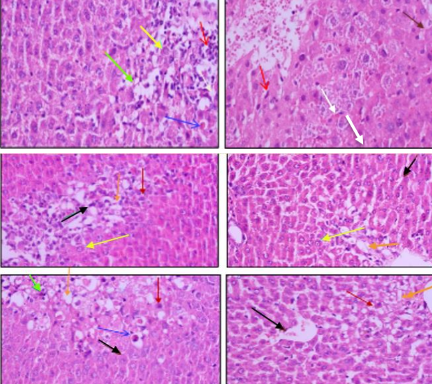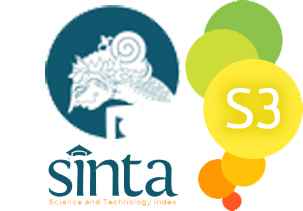A Hepatoprotective Effect of Extract Ethanol Gynura procumbens on Liver Injury Induced by Toxic Dose of Paracetamol
Abstract
Gynura procumbens is a plant that contains flavonoid compounds as antioxidants and has a hepatoprotective effect. A hepatoprotector is a compound that can protect the liver from liver damage. One way to determine liver function is to measure the enzyme activity of Serum Glutamic Oxaloacetic Transaminase (SGOT) and Serum Glutamic Pyruvic Transaminase (SGPT). This study aimed to determine the hepatoprotective effect of the extract ethanol of Gynura procumbens on the liver induced by paracetamol toxic dose. This study used 20 white male rats divided into five groups: positive control group, negative control (NaCMC 1%), and paracetamol dose of 2.400mg/kg bw). EDSNY 100 mg/kg bw, 200 mg/kg bw, 300 mg/kg bw + 2.400 mg/kg paracetamolThe rat blood samples were taken through the lateral vein, and then the SGOT and SGPT were measured before, after 4 days, and on the 6th day after paracetamol induction. The results showed that the ethanol extract of Gynura procumbens significantly reduced the levels of SGPT in mice at a dose of 300 mg/kg bw. However, the ethanol extract of Gynura procumbens leaves could not reduce SGOT levels in rats. From the histopathological results, it was evident that both low, medium, and high doses had not been able to significantly improve liver damage induced by toxic doses of paracetamol. However, the ethanol extract of Gynura procumbens leaves appeared to reduce the number of areas of necrosis and degeneration of hepatocytes compared to the negative control group. Based on the study's results, the ethanol extract of Gynura procumbens leaves at a dose of 300 mg/kg bw was able to protect against an increase in SGPT. Still, it hadn't shown that it was the best way to protect the liver from damage caused by too much paracetamol.
References
Dalimartha, S. (2006). Atlas Tumbuhan Indonesia. Jilid 4. Jakarta Puspa Swara.
Darminto, Ali A,dan Dini, I. (2011). Skrining Senyawa Bioaktif pada Tumbuhan Mangrove yang Dapat Menghambat Pertumbuhan Bakteri Penyebab Penyakit Red Spot Disease. Jurnal Chemica, 12(1), 33-39 https://doi.org/10.35580/chemica.v12i1.137
Departemen Kesehatan Republik Indonesia. (2010). Buletin Jendela Data dan Informasi Kesehatan. Jakarta: Departemen Kesehatan Republik Indonesia.
Gowda, S., Desai, P. B., Hull, V. V., Math, A. A., Vernekar, S. N., & Kulkarni, S. S. (2009). A review on laboratory liver function tests. The Pan African medical journal, 3, 17.
Heirmayani. (2007). Toksikopatologi Hati Mencit (Mus Musculus) pada Pemberian Paracetamol. Fakultas Kedokteran Hewan Institut Pertanian Bogor, Bogor https://repository.ipb.ac.id/handle/123456789/1660
James, LP, Mayeux, PR, dan Hinson, JA. (2003). Acetaminophen-Induced Hepatotoxicity. Drug Metab. Dispos. 31, 1499–1506. https://doi.org/10.1124/dmd.31.12.1499
Larson A. M. (2007). Acetaminophen hepatotoxicity. Clinics in liver disease, 11(3), 525–vi. https://doi.org/10.1016/j.cld.2007.06.006
Kaewseejan. N., Puangpronpitag. D., Nakornriab, M. (2012). Evaluation of Phytochernical Composition And Antibacterial property of Gynura Procumbens Extract. Asia J. Plant Sci. II. Hal: 77-82.
https://dx.doi.org/10.3923/ajps.2012.77.82
Larsen, F.S., dan Wendon, J. (2014). Understanding paracetamol-induced liver failure. Intensive Care Med. 40, 888–890.
https://doi.org/10.1007/s00134-014-3293-9
Sastrowardoyo, S. (2004,) Potensi Ekstrak Buah Mengkudu Sebagai Hepatoprotektor Pada Mencit yang Diberi Paracetamol. Jurnal Medika No. 5 tahun 2004
Senja, Y. (2014.) Comparing extraction method and solvent variation on Yield And Antioxidant Activity of Brassica oleracea L. var. capitata f. rubra Extract'. Traditional Medicine Journal Faculty of Pharmacy,. 19(1).
https://doi.org/10.22146/tradmedj.8090
Sherlock, S. (2004). Penyakit Hati Saluran Empedu. Cetakan kedua. Jakarta: PT Arkanz
Takude, R.L. (2014). Gambaran Histopatologi Hati Tikus Wistar yang Diberikan Boraks. Jurnal E-Biomedik (Ebm). 2(3):1-6. https://doi.org/10.35790/ebm.v2i3.6209
Vakiloddin, S., Fuloria, N., Fuloria, S., Dhanaraj, S. A., Balaji, K., & Karupiah, S. (2015). Evidences of hepatoprotective and antioxidant effect of Citrullus colocynthis fruits in paracetamol induced hepatotoxicity. Pakistan journal of pharmaceutical sciences, 28(3), 951–957.























